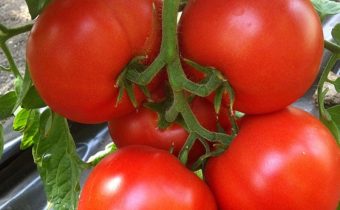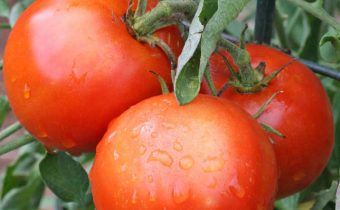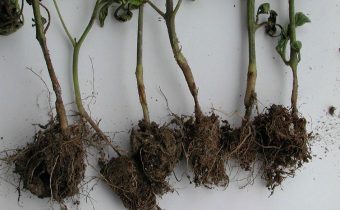The variety of tomatoes "Legend Tarasenko": reliable and fruitful
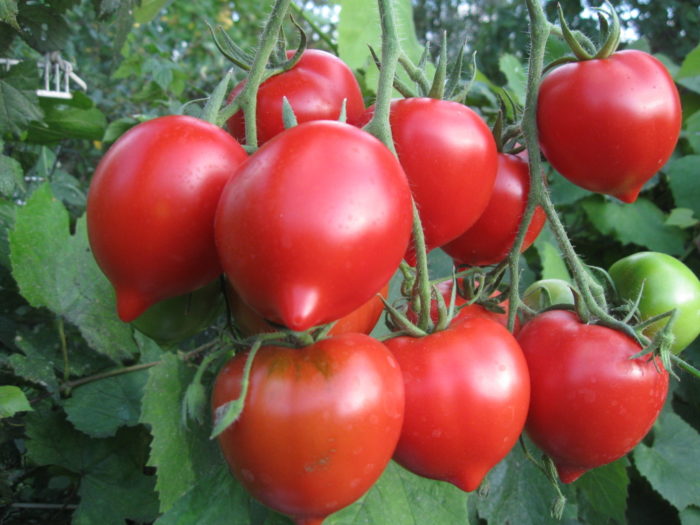
One variety from this family is the stunning tall brushed tomato legend Tarasenko (multiflora) - reviews of tomato lovers and photos confirm information about the reliability and yield of this variety.
This mid-early lianovid variety is distinguished by the power of high branchy bushes with a large number of brushes.
Description
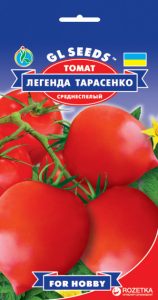 Indeterminate plant, up to 1.5 m in the beds and up to 2.5 m in greenhouses. It has a powerful, deep-rooted root system. Fruits form complex brushes of the fan type. In one brush can be up to 30 tomatoes.
Indeterminate plant, up to 1.5 m in the beds and up to 2.5 m in greenhouses. It has a powerful, deep-rooted root system. Fruits form complex brushes of the fan type. In one brush can be up to 30 tomatoes.
For fruits the following is characteristic:
- Elongated oval shape, plumiform, with a pointed tip.
- Average weight - 100-110g.
- Taste is pleasant, without sourness, the pulp is juicy, fleshy.
- The color when ripe is red.
- The skin is shiny, dense, not prone to cracking.
The ripening of the fruits in the hands is almost simultaneous, the first fruits turn red after 110-120 days after germination. Fruiting stretched, sometimes (in greenhouses) lasts until the frost.
Thanks to the pleasant taste, the fruits are widely used in cooking. However, despite its universal purpose, tomato is a legend of multiflora, which, according to reviews, is considered to be an ideal pickling variety, since it does not crack when processing whole fruits.
Advantages and disadvantages
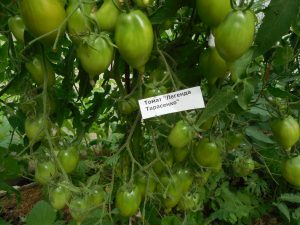 Most often gardeners note such positive qualities of the variety:
Most often gardeners note such positive qualities of the variety:
- High yield.
- The term of fructification extended till autumn.
- Lay-rate - according to reviews, when creating the necessary conditions, the fruits can be stored until the New Year holidays.
- Excellent taste
- Transportability.
- Universal purpose - in conservation, fresh form, for making juices and ketchups.
The disadvantages include:
- High requirements for the composition of the soil (to obtain a crop, the soil must be well fertilized).
- The greater height of the bushes, the need for garters to high supports not only the stems, but also brushes.
- Mandatory formation, as without removing the stepsons and lower leaves, the plant thickens and its crop falls.
See also: Green Tomatoes: Description and Characteristics of Emerald Varieties
Features of growing
Since the legend Tarasenko (multiflora) tomatoes, according to their characteristics and description, belong to the middle-early varieties, they are grown in open ground mainly in the southern regions of Russia.
The use of greenhouses prolongs the period of fruiting until late autumn.
Disease and Pest Resistance
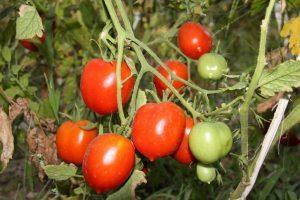 According to the amateurs who grow these tomatoes, the variety, subject to agricultural practices, is resistant to most of the nightshade diseases. In order to prevent plant diseases, it is important to observe the following rules:
According to the amateurs who grow these tomatoes, the variety, subject to agricultural practices, is resistant to most of the nightshade diseases. In order to prevent plant diseases, it is important to observe the following rules:
- To return tomatoes to their original place or after other nightshade is not earlier than after 3-4 years.
- When using greenhouses to carry out autumn antifungal processing of the structures themselves, equipment, as well as the soil.
- Keep plants clean from weeds, provide them with good light.
- Before sowing seeds, carry out preventive treatment with a disinfectant solution.
- If there is a danger of the disease, conduct preventive spraying with copper-containing preparations, phytosporin or folk remedies - infusions of garlic, bitter pepper.
The most dangerous pests of tomatoes are the spider mite, whitefly, Colorado potato beetle. In small areas, they usually do not use chemical control agents, but collect them manually or spray them with one of the infusions - tobacco, onion peel, birch tar.
Growing seedlings
To get a full crop of tomatoes, they start sowing 55-60 days before planting in greenhouses or open ground.
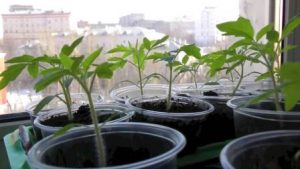 Land for growing seedlings should be nutritious, but at the same time quite loose. The best option - a mixture of fertile garden land with humus, ash and peat.
Land for growing seedlings should be nutritious, but at the same time quite loose. The best option - a mixture of fertile garden land with humus, ash and peat.
Before sowing, the seeds are treated in a 1% solution of potassium permanganate for 15–20 min, after which they are immersed in a solution of trace elements or growth stimulants.
You can use garlic juice as a natural disinfectant, and honey and aloe juice as growth stimulants.
As soon as the first loops appear - in this form the plants appear from the ground - the container is placed on the light. If the weather is overcast, apply artificial lighting.
Watering seedlings during this period should be done very carefully, since young plants are very susceptible to fungal diseases.
After the plants appear in several true leaves, they start picking. Tomatoes are seated either in a more spacious container for a distance of 15-20cm between them, or in separate pots. In any case, plants should not obscure each other.
If plants are weakened for some reason, they are fed with seedling fertilizer (1-2 times for the entire growing period).
See also: Why does tomato seedling turn yellow and what to do about it?
With sustained warming, seedlings are carried out to the open air, to greenhouses, to open balconies.
Transplant into the ground
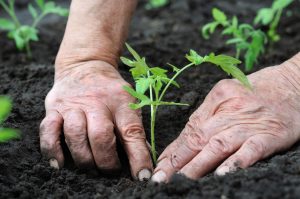 Planting of plants is started when frosts recede, but even in this case, it is advisable to be safe and have temporary shelters - arcs and material for shelters - film, agrospan, spunbond.
Planting of plants is started when frosts recede, but even in this case, it is advisable to be safe and have temporary shelters - arcs and material for shelters - film, agrospan, spunbond.
A place for planting tomatoes is chosen taking into account the best predecessors. They are green, pumpkin crops, bows.
Since the Legend Tarasenko variety is very picky about the composition of the soil, preparation of beds in open ground or in a greenhouse is carried out in advance: the holes dig deep ones - up to 40 cm, lay in them rotten manure or compost, ashes, and mineral fertilizers.
Plants are planted at a distance of about 1 m, and between rows - up to 1.5 m, only such a landing will provide sufficient illumination of the bushes.
Care
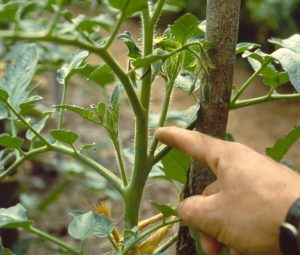 To get a full harvest, it is important for plants to ensure proper care:
To get a full harvest, it is important for plants to ensure proper care:
- Powerful bushes of tomatoes require infrequent (once in 7-10 days), but abundant watering. In this case, it is desirable to supply water directly under the root. Good result gives the use of drip irrigation systems.
- Soil mulching helps retain moisture and prevent weeds. If grass is used as mulch, hay, any weed weeds, when rotting, they will provide plants with additional nutrition.
- Garter to the support is necessary, since even strong bushes can not always cope with the weight of the fruit. It is important to tie not only the main trunks, but also individual brushes.
- Form a plant usually in 2-3 stalks. Lower leaves and stepchildren are removed. When staving leave small processes (1-2cm) so that new ones do not grow in their place.
- When growing tomatoes in the greenhouse, it is necessary to provide ventilation with the help of doors and air vents, since the increased air humidity can cause fungal diseases.
- Fertilizing in the process of growing tomatoes is carried out, both nitrogen-containing liquid - diluted with an infusion of herbs or mullein, and mineral fertilizers (phosphate and potash) - after flowering. Usually feeding is carried out every two weeks on wet ground.
- At the onset of the autumn cold snap, the crop on the bushes is rationed - the flowers and weak ovaries are removed, the fruits are ripened in technical ripeness.
See also: Tomatoes "Giant raspberry": a variety with long-term fruiting
Video: 9 Secrets to a Good Harvest Tomato


 (1 ratings, average: 4,00 from 5)
(1 ratings, average: 4,00 from 5)